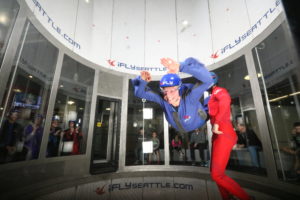Our family looked forward with anticipation to our iFLY Indoor Skydiving date. There would be ten of us, a “party package.” The closest iFLY facility was iFLY Seattle, which really is in Tukwila, by Southcenter Mall.
We all arrived at the appointed time, one hour before flight time. We checked in individually at computer terminals. At that time we declared our fitness and our understanding of the health restrictions. For instance, the weight limit is 300 pounds, and people with histories of heart issues, back injuries or shoulder dislocations should not attempt this sport.
After check-in, we watched the previous group, a valuable experience. We gathered around the glass-encased flight chamber, a vertical wind tunnel. The tunnel has fans at the top to draw air through the flight chamber. The air is then pushed back down the sides through return air towers and repeatedly pushed through the flight chamber. The result is a smooth column of air that enables flight.
According to iFly’s website: “The invention of modern wind tunnels has given skydivers a consistent and practical way to develop and hone skills that usually require jumping from a plane. Additionally, the increase in availability of wind tunnels has created a whole new genre of sport: bodyflight. It is one of the most exciting and fastest growing sports in the world.”
We were all beginners, but the instructors at iFly can train people interested in bodyflight to pursue the sport and even go into competition.
As we watched, I realized it was nothing like I expected it to be. I had envisioned us all flying around a room. But it was clear that an instructor needs to be with you at all times, and he takes one only person at a time. Further, I expected to keep my body in a straight horizontal line, but as I watched, I saw that participants arched their body to form sort of a “V.” I could see why people with back problems might want to avoid this sport.
After watching the previous class, we were ushered into a classroom and briefed on what we should expect. Our instructor David went over hand signals, maneuvers, and explained the equipment we would use.
I was amazed with the amount of gear. We were instructed how to insert earplugs. Flight suits were furnished, equipped with “handles” for the instructor to grab. We wore our own closed-toe shoes. Goggles were adjusted to our faces, then helmets issued to protect our heads. I wondered how many people “bailed out” at this stage. We all hung in there, game for the adventure.
We sat just outside of the chamber, facing a new crowd that would follow our party. One at a time we went in with David. I was amazed at the strength of the wind. He instructed each one of us the “basics” ensuring that we understood the rudiments of the sport. Then, one at a time again, we had our second round of flight, this time more advanced and going aloft, the equivalent of 2 stories high. I found it exhilarating.
After everyone had gone through the process twice, we watched as David performed some impressive bodyflight maneuvers. We had a long way to go if we wanted to achieve that level of proficiency.
Our iFly date was fun—another great family adventure. To learn more about iFly, visit https://www.iflyworld.com



Driving on the freeway here in Phoenix, I saw a strange cylindrical building with a sign attached advertising indoor skydiving. I wondered how that would ever work. Thanks for the detailed explanation. Your narrative, however, is not enough to convince me to ever try it. But I do admire you and your family. Good post.
We thought it was fun, but it’s not for everyone. Thanks for your comment, Judith.
Wow! It does sound like fun. I had never heard of it before, Mary. Love the idea of family excursions. Pretty Neat!
We like our idea, too, and so far it’s worked out. We never seem to run out of “original” ideas.
Mary, I covered a group of high school science students selected to put their science experiment on the NASA K-Bird Jet – also known as the Vomit Comet. The students trained for a week to qualify to fly with the experiment. As the journalist appointed to cover the group, I was given the choice to join them. In the end I was disqualified for the tiniest heart issue. I was allowed in the control room where I could watch the students on monitors during their zero G flight. Most were nabbed by trainees on the first fly-over and strapped down with a “bag” over their mouths. It takes a very special kind of fortitude and physical ability to fly in zero G. While the iFly is not weightlessness – I can still imagine how exciting it must of been! You go girl!
Karen, your journalism took you to interesting places and situations, didn’t it? This was an exciting event, and different from what I had expected. This is the type of thing we’re doing for Christmas now with the four kids and their spouses (or whatever). One year we took a steam train around the base of Mount Rainier, the next year whale watching in Puget Sound, we’re going to go zip-lining in a couple of months (that was Christmas before-last, but one of our sons was out-of-state). We prefer this to individual gifts, which they really no longer need.
Wow. Did you do this recently, Mary? It had to be a very different experience. I admire you in any event, I want a whole airplane around me when I’m aloft.
Yes, just a few weeks ago. It was our Christmas present to the family.